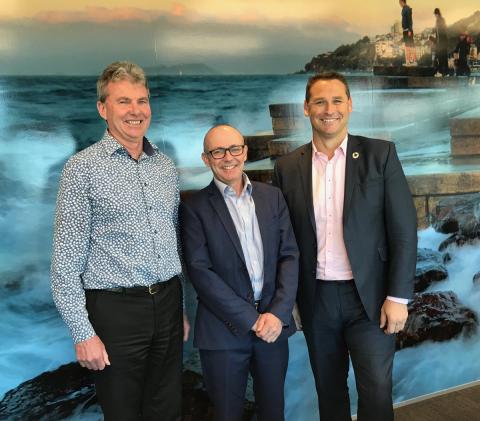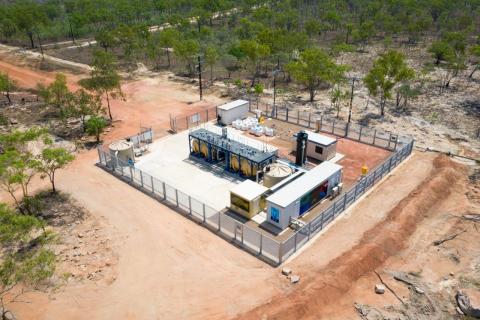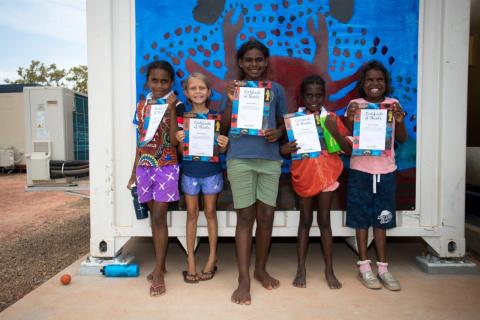With trips to remote Borroloola in the Northern Territory and over the Tasman to Wellington, New Zealand our Executive Director Adam Lovell shares insights on urban water reform and indigenous engagement programs.
I’ve been over in Wellington over the past couple of days discussing our submission to the New Zealand Department of Internal Affairs for their Three Waters Review. Let’s face it, in the absence of Federal Government appetite for urban water reform in Australia, it’s refreshing to engage with the NZ water industry on some major institutional and regulatory reform for drinking water, sanitation and stormwater services.

Image: Colin Crampton (left), Stuart Wilson and Adam Lovell in Wellington for the Three Waters Review .
It’s the subject of a separate piece but on the back of challenging recommendations following the Havelock North water quality incident a couple of years ago, the Kiwis are doing extensive background work on what’s worked and what hasn’t around the world. WSAA has pulled together commentary around the TasWater story, plus the Victorian regional and south east Queensland set up, added some of our previous work on economic regulatory reform and governance, bundled it up and contributed to the debate.
It’s always a complete pleasure to talk with Colin Crampton who leads Wellington Water in the ‘coolest little capital’ in the world. After working through some of the usual commercial issues (including how Wellington Water is working more closely than ever with its local government shareholders) Colin leant back in his chair and said, “Well, you know there’s something bigger, something more important than customer first…”
Intrigued by the twinkle in his eye, Colin talked to us about:
Te Mana, e te mouri, o te wai
I’m hoping to give this statement justice but it sums up the existential powerfulness and spirituality of water to the Maori people. ‘Ki uta ki tai’: from the mountains to the sea, the unbroken water cycle, a catchment based approach that over the years we have ‘adjusted’ from a Western perspective. Colin is deeply passionate that the reform program in New Zealand captures these core Maori beliefs in their water planning and delivery.
Which is a great segue way into a confronting and yet powerful trip I made to the Northern Territory for the opening of a new water treatment facility at Borroloola a few weeks ago. The town of Borroloola, located on the McArthur River, about 1000km from Darwin near the Gulf of Carpentaria, has a population of around 1000 people. During the wet season it can be cut off from land access for many weeks at a time. The bore field raw water available has a low pH (around 4) and high dissolved CO2, terrible to treat and terrible for pipes. Power and Water Corporation has been working over an extended period of time to upgrade the water quality delivered to the town. They commissioned Suez to design and construct a compact water treatment facility resilient to the ravages of the brutal climate up there. Suez did a fantastic job designing the facility, building it in Darwin, semi commissioning the plant, taking it apart again and transporting it to Borroloola and reassembling on site.

Image: Aerial photo of Borroloola Treatment Plant. Power and Water Corporation.
What impressed me the most was the engagement program Power and Water Corporation pulled together, particularly with the local school. The project manager, Eric Vanweydeveld, spent at least 18 months talking to the school and the local community about the water quality issues and ways in which the community would view the facility as part of the ‘infrastructure’ of the town, something to protect.
By the way, Eric recently was awarded Gold in the Young Project Manager of the Year Awards and when I caught up with him last week he was down in Alice Springs very modestly getting on with his work.
What Eric and Power and Water Corporation managed to deliver was very powerful – the water treatment kit is literally covered in artwork the local kids completed at school. The artwork mostly depicts water life from the local Macarthur River. Given the site is unmanned for long periods of time, and with 13 months of no vandalism, it’s been a tremendous start.

Image: Children at the Borroloola Treatment Plant official opening. Power and Water Corporation.
Michael Thomson, the Managing Director of Power and Water Corporation, is keen to see similar models of engagement rolled out across the many other remote indigenous communities they service (together with the Department of Housing). It was a valuable visit, the kids were super excited with yo-yos, handballs, water bottles and a quick site tour, which sadly contrasted against a population with large rates of suicide and unemployment.
The local Mabunji Aboriginal Resource Indigenous Corporation has just constructed a new crèche and other vital works around the town, services that support and add to the water treatment facility to help uplift the health of the local community. As Maria the local indigenous school teacher (beaming with pride as she wandered around looking at the artwork) said – ‘it’s one less thing to worry about, one more thing to be happy about’.
The WSAA Liveable Communities Committee chaired by Louise Dudley, CEO of Queensland Urban Utilities has been looking closely at remote and indigenous services and we are very pleased to be partnering with University of Queensland, Griffith University and the Institute of Sustainable Future to scope out remote indigenous community needs for water and sanitation through a lens of values and equity. All of these partners have been involved in the past in co-designing water programs with indigenous communities to deliver services that make a tangible difference to the health and wellbeing of these communities. Jennifer Bartle-Smith in WSAA’s Melbourne office is leading this program so please contact her if you’re interested in knowing more.
This all circles back to the United Nations Sustainable Development Goals and the commitment many WSAA members (including Wellington Water and Power and Water Corporation,) have made to achieving SDG6 Clean water and sanitation by 2030. In conjunction with the Australian Water Association and WaterAid we are collaborating to make a difference in Australia, New Zealand and in Southeast Asia. I invite anyone to join the journey – as together we work will our indigenous communities here in Australia and embrace our own ‘Te mana, e te mouri, o te wai ‘ the powerful connection of Maori people with water.
